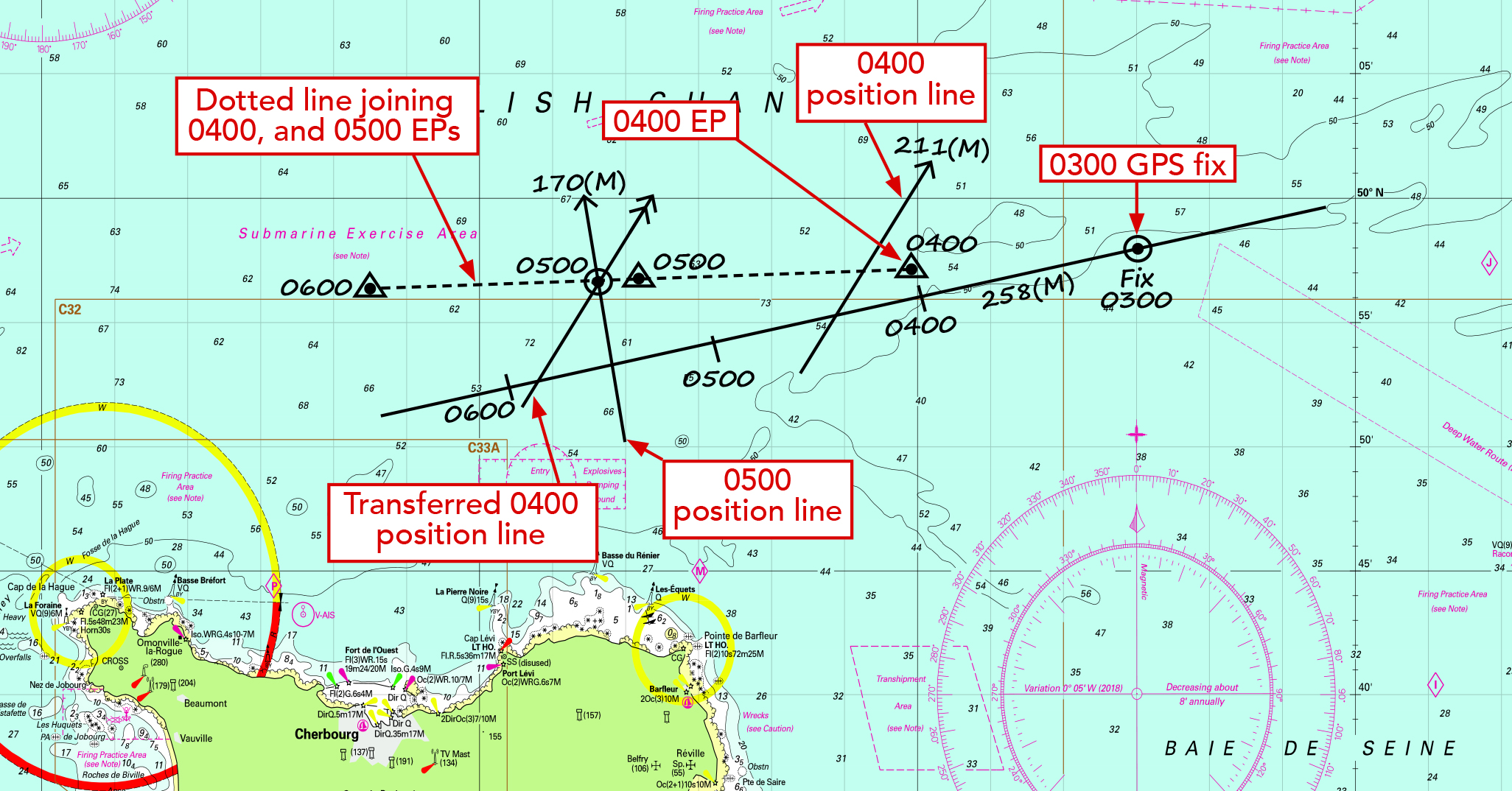Running Fix
Book Extract
Running fixes are handy when you are starting to run out of fixing options. It’s not a technique that’s used very often because, frankly, it takes quite a lot of effort. What’s more, there is a lot of opportunity to build errors into the fix, so it may not be particularly accurate. To be honest, I doubt if I would use it when simpler fixing methods are available. But it’s one more option to have up your sleeve and it’s saved my bacon on more than one occasion. With a running fix, you only use one fixing mark, but you use it more than once, to give you a multiple position line fix.

Plotting a running fix (Imray chart 12)
Suppose you’re heading southwest down the Channel. It’s the middle of the night and you are just coming up to the Cotentin Peninsula with Cherbourg on your port bow. You have no radar and the GPS stopped working when your daughter’s teenage boyfriend tried out a new pair of pliers that he had been given for his birthday, and inadvertently cut through the GPS aerial cable in the cockpit. The visibility is poor, limiting your visibility to just a few miles.
You are steering a course of 258ºM at a log speed of 10 knots
The tidal stream is flowing at 310ºM, 2kts
Variation on the chart is 0º 42’W (in 2020)
Your last fix, before your daughter’s boyfriend got cracking with his pliers, was an accurate GPS position at 0300 BST. You have plotted a DR on the chart for 10kts for 0400, 0500 and 0600, and you have also laid off EPs from these DR positions at a distance of 2, 4 and 6nm to the northwest of the respective DR positions.
Suddenly, at 0400, the visibility clears for long enough to take a bearing of Pointe de Barfleur Lighthouse on the northeastern corner of the peninsula. The bearing is 211ºM.
You plot this position line on the chart, which gives you some reassurance because it passes close to the northwest of your 0400 EP. You could, if you wish, ‘update’ your 0400 EP to the closest point on that bearing line. But you haven’t yet got enough for a reliable fix: you need a second, crossing bearing line.
As luck would have it, at 0500 you get a second bearing of Pointe de Barfleur Light, now on a bearing of 170ºM. You plot that bearing on the chart and again it passes a mile or so to the west of your 0500 EP. But again, this alone isn’t a fix.
However, if you were to move your 0400 position line in the same direction and the same distance as the boat has moved (that is to say EP to EP) from 0400 and 0500, you could justifiably use this transferred position line to give you a cut and a reasonably accurate 2-position line fix.
Now for the clever bit…
To transfer the 0400 position line:
First of all, draw a dashed line on your chart joining the two EPs at 0400 and 0500
Set up your dividers with one point on the 0400 EP and the other on the 0500 EP
Now, without disturbing the separation of your divider points, shift the ‘0400 point’ along the dashed line until it hits the 0400 bearing (211°M)
Mark the spot on the dashed line where the ‘0500 point’ of the dividers has now shifted to
Draw a line parallel to the 0400 bearing (211°M) through that spot; this is your transferred position line, and the convention is that you mark it with a double arrow
Where the 0500 position line (bearing 170ºM) cuts the transferred 0400 position line (211°M), you can now justifiably put your spot and circle, and call it the 0500 fix
At the end of the day, this is just a 2 position line fix, and even then it is only as good as your DR and your assessment of the tidal stream, but when you are scrambling around for a fix, you would be surprised how welcome even this can be. And you can of course subsequently add a third bearing line to increase the accuracy of the fix.
This sounds long-winded, because I have deliberately taken the procedure step-by-step, but with practice it can be done quickly and easily at sea. You will seldom use a running fix, even if you spend a lot of time at sea, but it’s worth tucking the technique away because, when you run out of fixing options on a stormy night, it’s pure gold dust.
© Not to be reproduced without written permission from Fernhurst Books Limited.
Mastering Navigation At Sea is written Paul Boissier. Paul Boissier has spent much of his professional career working on the sea, or in support of the people who go to sea, and in his leisure time he is an avid yachtsman. In the Navy he commanded and navigated warships and submarines in many parts of the world, ending his career as a senior Admiral. He then spent 10 years as Chief Executive of the Royal National Lifeboat Institution, the charity that saves lives at sea and operates over 340 lifeboats around the UK and Republic of Ireland. This lifetime’s experience has given him a unique perspective on navigation, from the bridge of a warship, to the cockpit of a cruising yacht and the control room of a submarine.